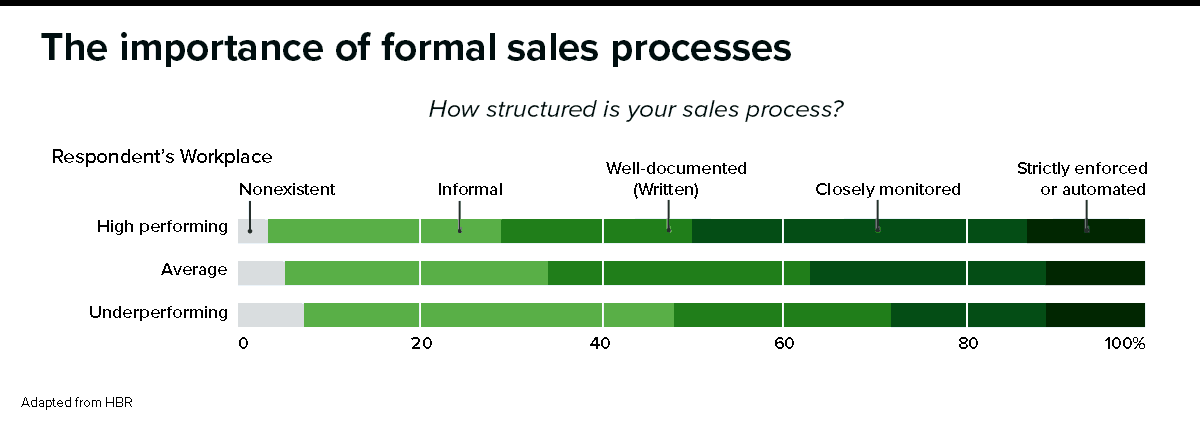
Data-driven success proves itself time and time again. In an age characterized by disruption and restless competitive threats, gut instinct is a dangerous basis to make decisions on. Now is the time for sales leaders to examine the scientific metrics of a high-performing sales force.
Based on the latest research and hard-earned experience, here are seven characteristics that differentiate highest performing sales teams from the average ones.
1. The best sales organizations hunt on the farm.
It is five to twenty-five times more expensive to gain a new client than retain an existing one. That’s why top sales organizations invest in existing accounts. They maximize account potential by selling to existing clients. This is also referred to as hunting on the farm.

To encourage this focus, top sales organizations adjust compensation plans

Additionally, the best leaders coach their teams to “go micro”.
Going micro means:
- learning the micro markets within a territory,
- knowing where their clients are adding capacity, and
- where there are opportunities for future expansion.
In top performing sales organizations, reps know which products each account uses. They learn the details of each client. They anticipate potential problems by suggesting useful products that fix or prevent the difficulties that their clients face.
2. Top performing sales organization sell the way their customers want to buy.
Because customer loyalty has dropped 20%, top sales organizations can’t use only one sales methodology. They must be flexible. And that flexibility makes customers 30-50% more likely to become enthusiastic promoters and repeat customers.




- When the buyer is comfortable with conflict, 64% prefer sellers to challenge their thinking. Top reps alert their clients to the dangers of the status quo.
- They don’t ask leading questions but instead engage in consultative interactions with the clients.
- They also engage in solution selling. This allows them to target a client’s pain points and offer an appropriate remedy.
In addition, they capitalize on ease of purchase. They include the right people at the right time. Reps are encouraged to work cross-functionally to maximize the channels through which customers interact with the brand. Reps in high performing sales organizations create a frictionless journey from the initial consideration to the moment of purchase.
3. In top performing sales organization, reps expertly manage their pipelines.
High performing sales organizations train their reps to manage their own pipelines. They hold them accountable for quantifiable, binary results. When the time comes for feedback and quarterly reviews, reps are measured based on their quota.




Companies that have an effective process in place for pipeline management see a 15% increase in profit.
“High performing sales teams think in terms of strategic sales process management, while under performing sales teams are more focused on personal sales prowess,” say Steve W. Martin and Nick Hedges.
High performing sales leaders keep their teams focused on executing their strategic sales goals.
4. Top sales organizations have strict processes.
In Steve W. Martin’s study of 786 sales professionals, half of sales reps from top performing sales organization organizations whose annual revenues increased significantly year-over-year had rigorous sales processes. They were were closely monitored, strictly enforced or automated. Only 28% from under performing sales organizations described themselves as having strict sales processes.




In addition, top sales organizations set stretch goals within their rigorous systems to increase profit. It also allows them create a “superior” experience, something 80% of companies believe they provide, yet only 8% of customers agree. Even though they don’t expect all their reps to meet their quotas, they consistently set higher quotas by up to 50% more year over year.
5. Top organizations know that committees are easily influenced.
In B2B sales, there are an average of 5.4 people on buying committees. The best sellers know how to appeal to an audience. However, they also know that one committee member tends to bully others to their view. In fact, 90% of participants in HBR’s study confirmed that there is one person who sways the buying decision. 



Reps from top performing sales organizations are groomed to look for the bully. The committee member is successful at bullying the outcome 89% of the time. In instances like these, top sellers are aware of the group dynamics. They sell not only to the decision-maker, but to the bully.
6. Leading sales organizations are not afraid of market leaders.
The competition does not intimidate top performing organizations. They don’t buy in to the myth that market leaders dominate the demand. They know that 63% of buyers are open to buying from second-tier sellers that deliver equivalent value.
When selling to manufacturing, information technology, human resources, and accounting, top sellers know to tailor those methods to the price conscious needs of those departments. However, when selling to tech, banking, or consulting, they focus on delivering value because those industries are typically not as price sensitive. Fashion and finance, however, prefer to buy from the biggest names in business.
So top organizations don’t fixate on competing with the market leader. They focus on delivering value to their customers.
Selling is a data-driven process.
Instead of relying on gut-instinct, top organizations use tried-and-true methods to drive growth. They hunt on the farm, sell the way their customers want to buy, and accurately forecast their pipelines. They also have strict processes, know that committees are easily influenced, and are not intimidated by market leaders. The best sales organization rely on proven data to track their success.
To learn more about hiring strategies to become a top performing sales organization, click here.
relpost-thumb-wrapper
Related posts
close relpost-thumb-wrapper
Eliot Burdett
He co-authored Sales Recruiting 2.0, How to Find Top Performing Sales People, Fast and provides regular insights on sales team management and hiring on the Peak Sales Recruiting Blog.
Latest posts by Eliot Burdett (see all)
- 20 Of Our Favorite Books About Sales Management and Sales Leadership – October 20, 2023
- How To Make Progress On Your Sales Goal Without A Sales Leader – September 15, 2021
- Augment Your Recruiting Strategy During “The Great Resignation” – July 26, 2021




